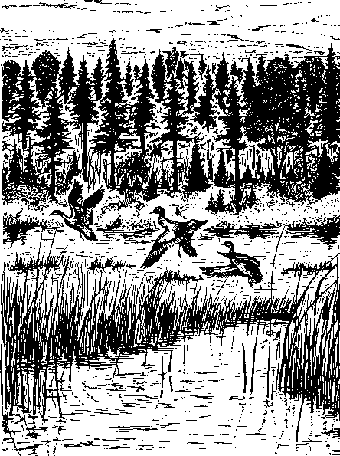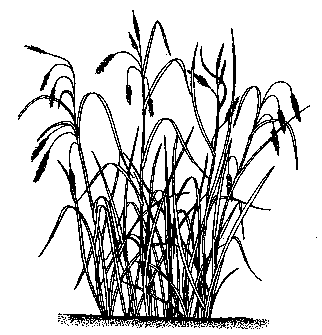
Eastern Habitat Joint Venture
 In quiet coves and protected shallows of lakes are found lakeshore wetlands, full of green and swirling with life. Patches of vegetation, such as swaying stands of rushes and floating mats of lily pads, mark out these habitats. Trout, minnows, dragonflies, black ducks and leopard frogs depend on lakeshore wetlands for food and cover. Although not as biologically productive as some other wetlands, lakeshore wetlands help to maintain the environment by preventing erosion of shorelines and supplying nutrients to lakes.
In quiet coves and protected shallows of lakes are found lakeshore wetlands, full of green and swirling with life. Patches of vegetation, such as swaying stands of rushes and floating mats of lily pads, mark out these habitats. Trout, minnows, dragonflies, black ducks and leopard frogs depend on lakeshore wetlands for food and cover. Although not as biologically productive as some other wetlands, lakeshore wetlands help to maintain the environment by preventing erosion of shorelines and supplying nutrients to lakes.
Lakeshore wetlands are generally nutrient-low wetlands that develop in protected shallow margins along lake shorelines. A wide variety of plants, ranging from grass-like sedges to water lilies, grow in zones on the shoreline that are non-rocky and where wave action is minimal. Aquatic plants can grow in shallow waters where there is sufficient penetration of sunlight to a lake bottom. In essence, lakeshore wetlands are pockets of marshy habitat that occur along lakeshores.
Several factors determine the kinds of plants that grow in each lakeshore wetland: water depth, nutrient level, amount of wave action and fluctuation in seasonal water levels. For example, broad-leaved plants such as pickerelweed and arrowhead flourish in calm protected areas. Thin-leaved plants like sedges and rushes are more tolerant of disturbance from wind and waves.
 whead whead |
 Sedge Sedge |
 |
|
Lakeshore wetlands often link with nearby marshes, swamps and fens, making it difficult to distinguish a border between adjoining wetlands. Consequently, lakeshore wetlands may appear as mixtures of several different types of wetland.
Wildlife of lakeshore wetlands
Lakeshore wetlands provide important wildlife habitat both above and below the water surface.
First and foremost are plants. A wide variety of aquatic plants live in lakeshore wetlands, including many rare species. Cattails, burreed, water-shield and water-milfoil are common plants in the shallow waters along the lakeshore. Several rare aquatic plants grow on lakeshores in the fluctuation zone created by changes in seasonal water level. Plants such as pink coreopsis and plymouth gentian, two members of Nova Scotia's rare 'coastal plain flora,' are specially adapted to survive along lakeshores that regularly experience large fluctuations in water level.
The vegetation of lakeshore wetlands attracts animals. Waterfowl seek protective cover and food in these vegetated shallows, as do many species of fish, frog and marshbirds. Many young fish use aquatic plants as cover to escape predators and as places to find insects, minnows and other food. Red-winged blackbirds and bitterns often nest in the cover provided by thick stands of cattail, rushes or sedges. Sandpipers, yellow-legs and other shorebirds frequently visit lakeshore wetlands during summer to feed and rest before migrating to their wintering areas.
Lakeshore wetlands and the environment
Most of Nova Scotia's lakes contain low nutrient levels and therefore are only moderately productive biologically. Nevertheless, lakeshore wetlands, in addition to providing habitat for wildlife, benefit the environment.
Brook trout  |
Wetland plants boost nutrient levels in lakes. The constant growth and decay of vegetation in lakeshore wetlands are important sources of nutrients for lakes and their inhabitants. Lakeshore plants also prevent serious erosion of lakeshores: their stems and leaves reduce the effects of wave action on shorelines and their root systems physically stabilise upper beaches.
Water pollution and shoreline development, especially for houses and cottages, are major threats to lakeshore wetlands. Natural lakeshore areas are gradually disappearing in Nova Scotia. Increasingly, buildings, docks, and roads dot the perimeters of once isolated lakes; shoreline that is developed for recreation or housing usually comes at the expense of nature.
Conservation
Many people dream of buying or building a quiet place by a lake. While seemingly harmless, this popular pursuit is taking its toll on lakeshores.
Helping lakeshore wetlands...
|
Moderation and awareness will help keep lakeshore wetlands thriving with wildlife. Vegetated shallows must be recognised as important refuges for wildlife and be left undisturbed. If people restrict their activities to less critical zones of shorelines, healthy lakeshore wetlands will remain for the benefit of both people and wildlife long into the future.
 |